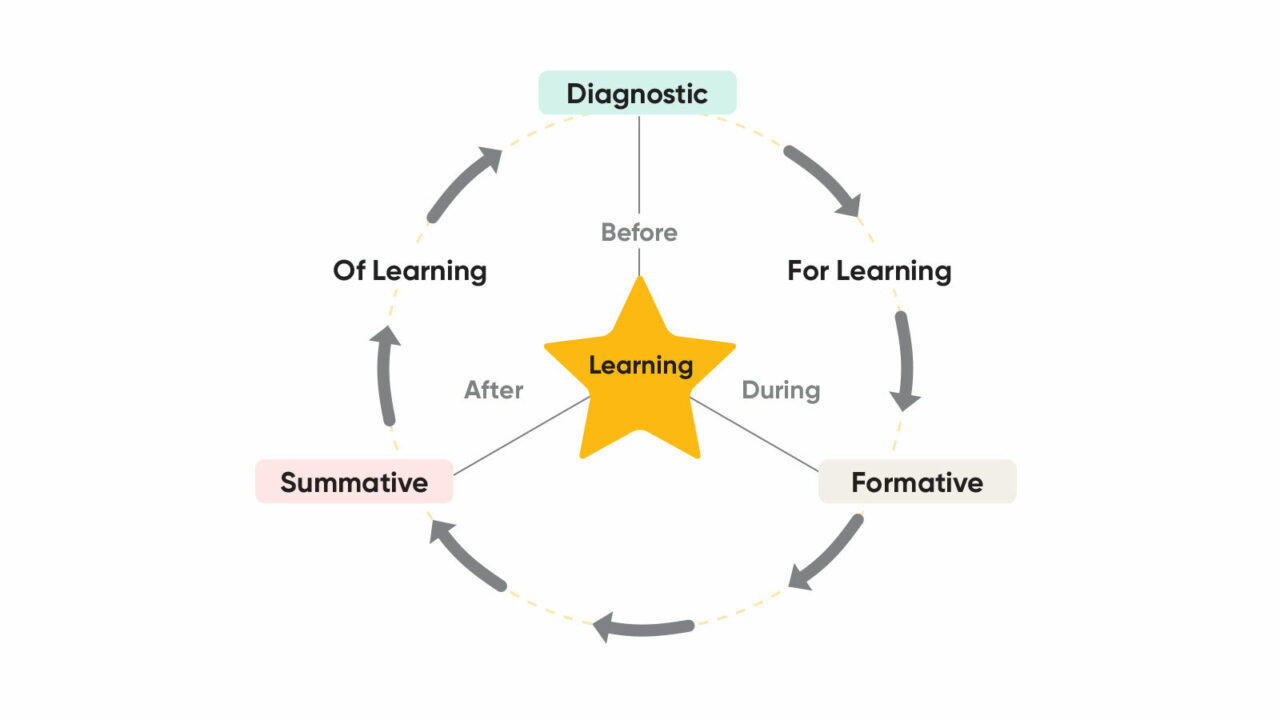
When talking with teachers and administrators, I am often asked what type of assessments they should be focusing on to better understand their students’ needs. The answer is always “it depends.” The right answer depends on the purpose of the assessment and what questions you are trying to answer with the data that will be elicited. Personally, I think that formative assessments provide the most meaningful day-to-day information and insights to teachers who can then adjust to what individual students need to be successful. But there are other types of assessments in education that provide meaningful information and insights for specific purposes along the teaching and learning journey.
What Are Assessments in Education?
Different assessments yield different data that can be used to support different insights.
So, to help you understand what type of assessment to use at which point in your teaching journey, I’ll describe the different types of assessments that may fit with your intended purpose and the ways that you can use assessment data to inform decision-making.
Educational measurement is about identifying what it is you’re trying to measure, figuring out what you can do to elicit that from a student, and then establishing a process to assign what you’ve elicited into a quantitative statement or number that can be evaluated. Essentially, as a measurement expert, I am trying to assign numerals to traits such as achievement, interest, attitudes, aptitude, intelligence, and performance to infer abilities and proficiencies of students.
Educators and administrators use assessments for a variety of purposes, such as identifying levels of achievement, evaluating strengths and weaknesses, and measuring progress. The assessment results can then be used to derive a variety of insights, such as how to personalize practice, differentiate instruction, and support accountability requirements.
What Are the 3 Types of Assessment?
Based on what it is you need from your assessments you can build a system of assessment that typically comprises three different educational assessment types that serve different purposes depending on when they are administered: diagnostic, formative, and summative. There are other labels for assessments like pre-test, post-test, progress monitor, benchmark, or growth assessment, but those all fall into one or more of these three broad categories.
- Diagnostic: When we think about educational measurements, each assessment is designed for a specific time and purpose. When an assessment happens before the learning activity, these are called diagnostic because the results can be used to diagnose problem areas to focus on during the teaching to come.
- Formative: When assessment happens during the learning process, these are called formative because the results can be used to inform what to do next for individuals or groups of students as learning is occurring. Both diagnostic and formative are types of assessment for learning - meaning you are assessing to support decisions made before or during learning.
- Summative: When assessments happen after the learning activity, these are called summative because the results are a summation of learning that has occurred.

Diagnostic Assessment
Let's dive deeper into each of these types of assessments. Let’s start with diagnostic assessments. In general, educators use these types of assessments to identify what students have yet to learn, diagnose any gaps in learning that will impede progress towards current learning objectives, or uncover any strengths that can be encouraged. Educators can then use this information to guide lesson and curriculum planning. Diagnostic assessments are most often thought of as being used at the beginning of the year, but they can occur at any time throughout the school year (e.g., to evaluate prerequisite knowledge gaps before moving on to the next unit of study).
Diagnostic assessments can be particularly helpful to teachers and administrators who may have a lot of new incoming students with unknown ability levels. Administrators can use diagnostic assessment information to decide on the curricula needed to support these students. Teachers can use the results to formulate personalized learning plans for individuals and assign students to groups for small group instruction.
Formative Assessment
Formative assessments are administered throughout the year, usually by classroom teachers. Their primary purpose is to inform teachers about how their students are progressing, where gaps exist in students’ learning, and how their instruction needs to be adjusted to improve student learning, possibly by slowing down the pace, repeating instruction, or even challenging some students with new and potentially more difficult tasks.
Formative assessments don’t have to be formal tests. They often include informal activities like hand signals, brain dumps, and entry/exit tickets, which give teachers informal and immediate feedback on student learning. They are often embedded as learning activities such as using concept maps or journal entries which means this can be assessment as learning. Even though some of these are very informal (like a thumbs up or thumbs down), teachers can use this data (be it quantitative or qualitative) to adjust their instructional groupings or reteach specific skills to students who seem to need help.

In fact, any systematically collected and evaluated display of learning can give teachers the insight they need to inform instruction. Formative feedback (be it more formal, like a quiz—or informal, like a thumbs-up) should be used daily to inform instruction and planning. By having the right data at the right time, you can make sure that:
- Instruction is appropriate for student's levels of development and needs
- Instruction is efficient and seamless
- Instruction provides students the time they need to grow or master the skills that are taught
- Instruction is sequenced flexibly and accommodates individual progress and answers the question ”what next?”
By evaluating along the way throughout the year and making micro just-in-time course corrections, you’ll be more likely to garner the best outcomes you intend for your students to achieve.
Both diagnostic and formative assessments are measurements for learning. Summative assessments are measurements of learning.
Summative Assessment
The final type of assessment is summative. Summative assessments occur after the learning activities or units of study have concluded. This is measurement of learning, and they are typically focused on evaluating proficiency or mastery of content after the end of a chapter, the end of the school year, or anything in between. These are measurements that conclude the learning process, such as final exams, end of unit tests, or large-scale standardized tests, and rarely inform instruction. They are mostly focused on measuring whether students grew their mastery or understanding of a pre-defined set of criteria (e.g., state standards).
A robust assessment system will include diagnostic, formative, and summative assessments in a comprehensive plan. The goal of such a system is to extend the effectiveness of teachers and administrators by providing them actionable data that diagnoses skill deficits, informs day-to-day instruction, measures mastery of intended learning objectives, and informs curricula choices.
In the best assessment systems, there is a strong focus on growth, not proficiency or mastery. There are many advantages to this focus:
- Growth targets allow teachers to set realistic learning goals that are individualized for all students based on where they are starting off their learning journey.
- Growth lets educators evaluate students individually and assess the impact of various learning solutions that have been provided.
- Growth recognizes that the teachers’ impact on student learning is not the same for each student due to variables outside of their control.
- And, most importantly, focusing on growth allows students of all ability levels to demonstrate improvement and achievement throughout the year.

It’s perfectly common for students to show growth yet still miss the idealized targets of proficiency or mastery. Focusing on growth is encouraging and validates the students’ hard work as they show progress on their individual learning journey.
Using Assessment Data to Make Decisions
So, now we understand the forms of assessments that yield data and their typical fit for purposes we can do a bit more with understanding how to evaluate and use assessment data. There are four basic steps in using assessment data:
- Gather data.
- Turn the data into information by ascribing meaning to the data.
- Convert that information into relevant insights.
- Act on those insights.

All assessments will yield data, and this data needs to be turned into information. Then from information you can derive insights and take appropriate actions. As an example, imagine you plant two flowers, A and B, at the same time and then measure their heights one week later. Plant A is 7” tall and Plant B is 5” tall.

This is raw data. To turn this into information, you would say “Plant B is 2 inches shorter than Plant A.” This is one way to find meaning in the difference between the raw numbers of 7 and 5 that provides information that drives insights. The insight is that Plant B is not growing as quickly as Plant A and must need something more or different. Perhaps Plant B needs a warmer environment, more nutritious food, or more sunlight. So, with this insight you then take the action of changing the location, food, or climate of Plant B. Hopefully, you can see how this example applies to student differences and the differentiation that might be needed!
There are thousands of opportunities to gather data, either formally or informally, along a student’s learning journey. And, just like the many opportunities to gather data, there are likely almost as many ways to use that data. I’ll cover nine of the broadest categories although I’m not promising I haven’t missed some!
- Monitor Growth: Monitoring growth refers to measuring change in student performance within and across years. This is arguably the most important way to evaluate student performance.
- Identify Strengths and Weaknesses: When measuring strengths and weaknesses, we can use this information to inform placement into intervention programs (like Read 180 or Math 180) or assign practice programs (like Waggle or Writable) to help close gaps. Administrators and teachers can evaluate this information and look for opportunities for professional development.
- Make Comparisons: We can make comparisons of student, class, or school performance to evaluate effectiveness of teaching strategies or learning environments.
- Measure Mastery or Determine College Readiness: It is sometimes necessary to evaluate mastery or determine college readiness for accountability purposes. Often, especially in the U.S., there is mandatory federal- or state-level legislation that requires reporting of student outcomes to receive state or federal monies.
- Plan Professional Development: Unfortunately, summative test results are also used for teacher accountability, and that is not something I personally stand behind given the multi-faceted factors that influence student learning, and the teacher is just one tiny face of that prism. But teachers and administrators can look for patterns in the data that would suggest that different teaching strategies may be more effective or if professional development would benefit the teacher and therefore their students.
- Align the Curriculum: Administrators and teachers can review performance data to ensure that they are selecting the most appropriate curriculum and planning the best scope and sequence of topics for their students. And this is not a one-size fits all, because we must provide special instruction for students who need it.
- Improve Teaching Strategies: Administrators and teachers can review performance data to evaluate if they are hitting the target on key concepts and prerequisite skills while uncovering topics that may benefit from added support via professional development, teacher coaching, or supplemental curriculum.
- Provide Special Instruction: We can use data to group students on a variety of performance features (e.g., overall score, or weakest domain-based score, or strongest domain-based score, missing prerequisite knowledge) and use this same information to personalize their learning journey in the most expedient way to get back on track.
- Predict Future Performance: We can even use current performance data to predict future performance data; this also helps teachers and administrators know where to focus their limited resources.
If there is a question to be asked or a problem to be solved, there are data out there waiting to be discovered or elicited that can help answer your questions or solve your problems. I have yet to encounter a question whereby there was no data source to help answer it. And knowing what decisions you need to make is how you determine which assessment fits your purpose. You need to ask yourself “What decisions am I trying to make” or “What problem am I trying to solve.” The answers to these questions drive when you assess (before, during, or after learning), what you assess (gaps, proficiency, mastery, growth), and how you assess (diagnostic, informal formative, formal formative, or summative).
***
If you are seeking advice on how to use the different methods of assessment, Dr. Julie Miles also hosted a webinar on using assessment results to optimize decision making.
Get a free guide to choosing the right assessments for your district.














